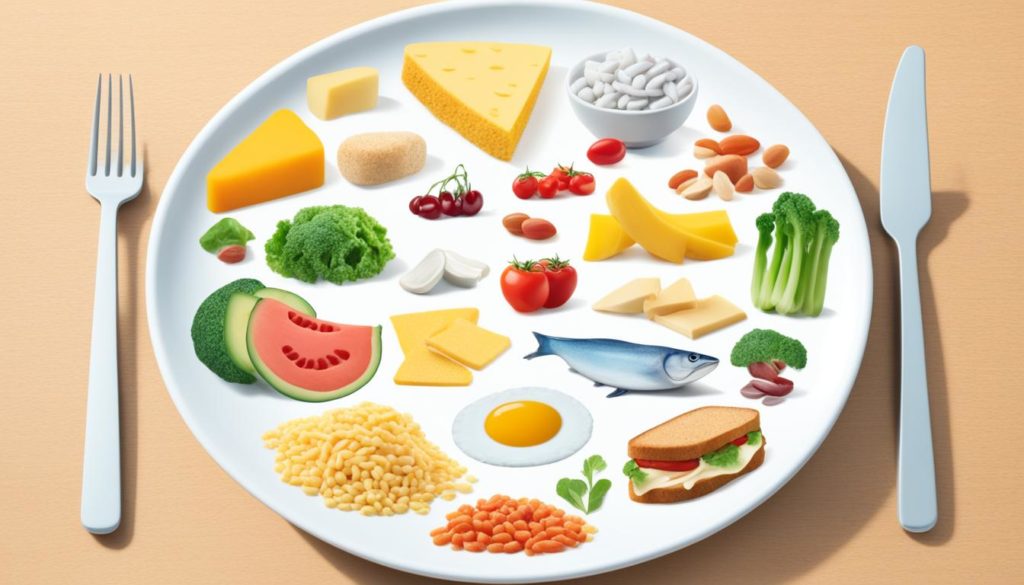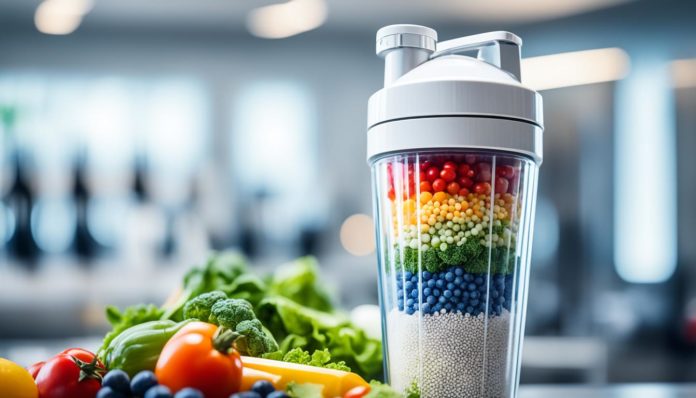Sodium is more than just a table ingredient. Our bodies need it in small amounts for cell function and fluid balance. It helps conduct nerve impulses and muscle movements. Yet, eating too much sodium, especially from processed foods, can cause problems. These include high blood pressure, heart disease, and stroke. So, it’s crucial to find a balance in sodium intake to stay healthy and avoid chronic illnesses.
Key Takeaways
- Sodium plays a crucial role in maintaining electrolyte balance.
- It supports nerve function and muscle contraction.
- Most dietary sodium comes from processed and packaged foods.
- Excessive sodium intake is linked to health risks like hypertension, heart disease, and stroke.
- Maintaining proper mineral intake is vital for overall health.
- Reliable health information can help you manage your sodium consumption effectively.
The Importance of Sodium in the Body
Sodium is key to our body’s health. It helps balance fluids, support nerves, and keep muscles healthy. Adults have about 92g of sodium in them. This is found in fluids inside and outside cells and in bones.

Maintaining Fluid Balance
Sodium keeps our body fluids in check. It makes sure cells have the right amount of water. This is vital for blood pressure and staying hydrated. Kidneys manage sodium to keep everything balanced. Want to know more about eating right? Here’s a great guide on dietary fats.
Supporting Nerve Function
For our nerves to work, we need sodium. It sends electrical signals in the body, helping the brain talk to other areas. Without enough sodium, our nerves wouldn’t transmit signals well. This could mess up both voluntary and involuntary actions.
Muscle Contraction and Relaxation
Strong muscles also depend on sodium. It helps muscles move and hearts beat. Sodium is there for every muscle squeeze and release. Not enough sodium might cause cramps, weakness, or heart problems.
Recommended Daily Sodium Intake
For optimal health, it’s key to follow correct sodium intake. Adults and children have different needs. This ensures they get the right nutrition.
Guidelines for Adults
The American Heart Association highlights the need to control sodium. It helps reduce heart disease risk. Adults are advised to not go over 2,300 milligrams of sodium a day. However, less than 1,500 milligrams is best for heart health.
This approach aids in keeping blood pressure levels healthy.
Most sodium we eat comes from processed items. Over 70% of it in the U.S. is from such foods. Choosing wisely can help us stay healthy and within limits.
Sodium Needs for Children
Children need less sodium than adults. Guidelines adjust the amount based on their age. This ensures they do not have too much.
Starting low sodium habits early is beneficial. It helps avoid high blood pressure and heart problems later. Watch out for processed foods to stay within limits.

Sources of Dietary Sodium
It’s key to know where dietary sodium comes from to manage it well. Foods high in sodium appear naturally and in processed forms. Understanding this helps us choose what we eat wisely.
Processed and Packaged Foods
Processed foods are a big source of sodium. This category includes deli meats, pizzas, soups, and snacks. In fact, these foods cause over 70% of the sodium we eat in the U.S. Manufacturers add salt to these foods to make them taste better, stay fresh, and have a good texture.
| Food Type | Approximate Sodium Content |
|---|---|
| Deli Meats | 800-1,200 mg per serving |
| Pizzas | 600-1,500 mg per slice |
| Soups | 700-1,400 mg per cup |
| Snacks (e.g., chips) | 150-300 mg per ounce |
Natural Sources
Sodium naturally occurs in foods like dairy, meats, and some vegetables, making up about 15% of our sodium intake. Foods like milk have around 100 mg of sodium per cup. Vegetables such as spinach and celery also add sodium to our diet without extra salt.
Moreover, different salts like table salt and sea salt contain about 40% sodium. It’s crucial to use salt sparingly in cooking and at the meal table. That’s where about 11% of our sodium intake comes from.
Sodium and Blood Pressure
Eating too much sodium can cause your body to hold onto water. This increases blood volume and puts pressure on your blood vessels. As a result, you may develop high blood pressure, or hypertension. If left untreated, hypertension can lead to heart disease and stroke.
How Sodium Affects Blood Pressure
Sodium makes your body retain water, increasing your blood volume. With more blood flowing, your blood pressure shoots up. That’s why eating less salt is key, especially if you’re at risk for hypertension. It helps keep your blood pressure in check.
Risks of Hypertension
Hypertension doesn’t show early symptoms but can lead to serious problems. It can cause heart disease, stroke, and kidney issues. Lowering your sodium intake can help prevent these risks. Even reducing sodium by 1,000 milligrams per day can make a big difference. Start by reading food labels and choosing options with less salt.
| Sodium Source | Approximate Sodium Content |
|---|---|
| 1/4 teaspoon salt | 575 mg |
| 1/2 teaspoon salt | 1,150 mg |
| 3/4 teaspoon salt | 1,725 mg |
| 1 teaspoon salt | 2,300 mg |
Health Risks of High Sodium Intake
High sodium intake can lead to serious health issues. One main problem is its link to heart disease. This happens because too much sodium can increase blood pressure. This, in turn, may harden the arteries. When that happens, it can harm the heart and other blood vessels.
High sodium also affects the kidneys. It can either cause or worsen chronic kidney disease. This is because the kidneys have to overwork to get rid of the extra sodium. Over time, this hard work can damage them.
| Health Condition | Impact of High Sodium |
|---|---|
| Cardiovascular Disease | Increased blood pressure, artery stiffening |
| Chronic Kidney Disease | Kidney strain, potential damage from excessive sodium elimination |
| Osteoporosis | Sodium can affect bone density over time |
| Sodium-Related Health Conditions | Potential elevation in cancer risk, particularly stomach cancer |
High sodium can also lead to osteoporosis. This happens because sodium may cause the body to lose calcium in urine. Over time, this loss can lower bone density.
Moreover, research in journals like the New England Journal of Medicine and the American Journal of Clinical Nutrition shows an interesting fact. It reveals that Americans often eat about 3,400 milligrams of sodium each day. This amount is way above the suggested limit. Such high intake increases the risk of diseases related to sodium.
Identifying Sodium in Foods
It’s vital to understand your sodium intake to make better food choices. To start, learn to read nutrition labels and find hidden sodium sources. This knowledge helps in choosing the right foods.
Reading Nutrition Labels
The Nutrition Facts on food packages give key details. Focus on sodium per serving and its % Daily Value (% DV). A sodium % DV above 15% means it’s high in sodium. Also, check ingredient lists for salt or sodium compounds.
Labels might show terms like “unsalted,” “sodium-free,” “low-sodium,” or “reduced-sodium.” These terms tell about the sodium level in the product.
- “Low-sodium” foods have 140 mg or less per serving.
- “Reduced-sodium” foods are 25% lower in sodium than their original.
Hidden Sources of Sodium
Hidden sodium can be tricky. It’s in processed foods, fast food, and restaurant meals. Even seemingly unsalty items like cereals and pastries can up your sodium intake. Knowing these sources helps in making better food choices. Check out more on making informed food choices.
Let’s compare common foods and their sodium levels:
| Food Item | Sodium Content (mg) | % Daily Value |
|---|---|---|
| Processed Meats (2 slices of ham) | 600 | 25% |
| Packaged Soup (1 cup) | 800 | 35% |
| Fresh Apple (1 medium) | 1 | 0% |
| Canned Vegetables (1/2 cup) | 250 | 10% |
Managing your sodium is simpler with diligent label reading. Opt for fresh or low-sodium options to better your health.
Sodium Deficiency: Causes and Symptoms
Hyponatremia, or lack of sodium, is quite rare in the United States but it’s a serious issue. Knowing the causes and signs can help us catch it early. It’s key to keep sodium levels between 135 and 145 mEq/L for good health.
Common Causes of Deficiency
Many things can cause low sodium. A big cause is losing too much fluid. This can happen through a lot of sweating, throwing up, or diarrhea. Kidney problems like acute injury, chronic disease, or failure can also make the risk higher. Heart failure and liver cirrhosis add to the risk, as do certain conditions like Syndrome of Inappropriate Antidiuretic Hormone (SIADH).
Using certain meds or drugs like Ecstasy can also up the risk. This is especially true for older folks and women before menopause.
Symptoms to Watch For
It’s important to know the signs of low sodium for quick action. You might not notice mild hyponatremia. But when levels dip under 135 mEq/L, symptoms get worse. You could have nausea, vomiting, headaches, or feel weak. There might be low blood pressure, dizziness, and tiredness.
In serious cases, there can be mental changes, hallucinations, seizures, coma, or even death. Spotting these signs early can lead to quick treatment, helping to avoid big health issues.
| Symptom | Description |
|---|---|
| Nausea/Vomiting | Common initial signs of low sodium levels |
| Muscle Weakness | Caused by electrolyte imbalances affecting muscle function |
| Headaches | Resulting from cerebral edema due to severe hyponatremia |
| Seizures | Indicates critical levels of sodium imbalance necessitating urgent care |
| Altered Mental Status | Includes confusion, hallucinations, and impaired awareness |
Knowing these symptoms well helps in keeping an eye on our health. It lets people and doctors deal with sodium issues early, stopping serious problems.
Practical Tips to Reduce Sodium Intake
Lowering how much sodium you eat is important for a healthy life. It helps prevent health problems like heart disease and stroke. Here are easy steps for a low-sodium diet:
- Cook at Home: Making your meals means you decide how much salt to use. Choose fresh meat over processed ones. They have less sodium.
- Choose Fresh Produce: Eat fresh or frozen veggies without added salt. This is a big step towards eating healthier.
- Carefully Select Snacks: Pick snacks that have a low-sodium label. Some stores have dietitians to help you find these products.
- Condiment Caution: Be careful with sauces and seasonings. Use things like garlic or citrus juice instead of salt to add flavor.
- Read Nutrition Labels: Look at the sodium amounts on labels to choose healthier options. This simple act makes a big difference.
- Portion Control: Share meals when eating out. Restaurant food often has a lot of sodium, so sharing can help you eat less.
- DASH Eating Plan: This plan is low in sodium, cholesterol, and fats. It’s proven to reduce sodium intake and lower blood pressure. Experts recommend it.
- Seek Professional Advice: Talk to a dietitian for personalized advice on cutting sodium. For more info, check out this informative resource.
Following these steps for less sodium can improve your diet and health. Over time, you’ll enjoy the taste of your food more. Sadly, too many people in the U.S., including kids and adults, eat too much salt. Using these methods helps lower your salt intake. This means a lower chance of high blood pressure and less risk of heart problems and strokes.
Conclusion
After looking into sodium deeply, we see that eating the right amount of sodium is key for staying healthy. Even though guidelines recommend less than 2,300 mg daily, most adults in the U.S. eat about 3,400 mg each day. People at higher risk, like African Americans, those over 51, or with specific health issues, should aim for 1,500 mg. It’s vital to find the perfect balance to avoid health problems from too much sodium, such as heart disease. But, the effect of cutting back on sodium isn’t clear for everyone.
Making smart food choices is crucial for a healthy diet. Too much sodium is linked to a higher chance of heart problems. However, eating very little sodium might be bad for patients with heart failure who are getting strong treatments. This shows the importance of diet plans suited to each person and calls for more study, especially with people who have greater health risks.
For the best health, personalizing your diet is a must. Keeping an eye on how much sodium you eat and knowing about dietary guidelines can help avoid the bad effects of too much sodium. There’s still a lot we need to learn about sodium and health. This means more studies, using thorough methods, are needed, as many research works and health groups have said.
To learn more about how sodium affects health, read this detailed review. By understanding more about sodium, we can make better choices and live healthier lives.
FAQ
What is sodium and why is it important for our health?
Sodium is a key mineral and electrolyte. It keeps fluids in balance, helps nerves send signals, and muscles to contract and relax. It’s necessary for our health and normal body operations.
How does sodium help in maintaining fluid balance?
Sodium controls fluid levels inside and outside of cells. This ensures our bodies stay hydrated. It’s key for good circulation and digestion.
What role does sodium play in nerve function?
It’s vital in passing electrical signals through nerves. This communication enables us to move and feel things.
How much sodium should adults consume daily?
Adults should keep their sodium intake under 2,300 milligrams a day. That’s around one teaspoon of table salt. It helps avoid heart issues and keep blood pressure healthy.
Are children’s sodium intake recommendations different from adults?
Yes, kids under 14 need less sodium than adults. The limit increases as they get older but is always below adult levels.
What are common sources of dietary sodium?
A lot comes from processed foods, like deli meats and pizzas. Natural foods have sodium too but less so.
How does high sodium intake affect blood pressure?
Too much sodium makes the body hold extra water. This raises blood pressure and can lead to heart conditions.
What health risks are associated with high sodium intake?
High sodium can cause high blood pressure, heart disease, and stroke. It might also contribute to kidney disease and osteoporosis, along with some cancer types.
How can I identify sodium content in foods?
Check nutrition labels for sodium levels. Watch out for hidden sodium in sweet-tasting foods. Compare products to find lower-sodium options.
What causes sodium deficiency and what are its symptoms?
Losing too much fluid through sweat or illness can cause low sodium. Signs include nausea, confusion, and headaches. Recognizing these can help handle the issue early.
What are practical tips to reduce sodium intake?
Cook at home to control salt. Opt for fresh foods and lower-sodium snacks. Watch how much you eat. When eating out, check the food’s nutrition. This will help you eat less sodium and stay healthier.
Source Links
- Sodium in Your Diet
- Salt and Sodium
- Tame your salt habit
- Sodium
- Overview of Sodium’s Role in the Body – Overview of Sodium’s Role in the Body – Merck Manual Consumer Version
- How much sodium should I eat per day?
- Sodium reduction
- Your guide to low sodium eating and how to lower blood pressure
- Sodium sources: Where does all that sodium come from?
- Top Sodium Food Sources in the American Diet—Using National Health and Nutrition Examination Survey
- Shaking the Salt Habit to Lower High Blood Pressure
- Low Sodium Diet and Lifestyle Changes for High Blood Pressure
- Dietary Sodium and Health: More Than Just Blood Pressure
- Telltale Signs You’re Eating Too Much Salt
- What doctors wish patients knew about sodium consumption
- How to Read a Food Label to Limit Sodium: Care Instructions
- Track Your Sodium
- Hyponatremia – Symptoms and causes
- Hyponatremia (low sodium level in the blood)
- Tips for Reducing Sodium Intake
- Halt the Salt: 5 Ways to Cut Down on Sodium and Improve Your Heart Health
- Sodium Intake and Health: What Should We Recommend Based on the Current Evidence?


